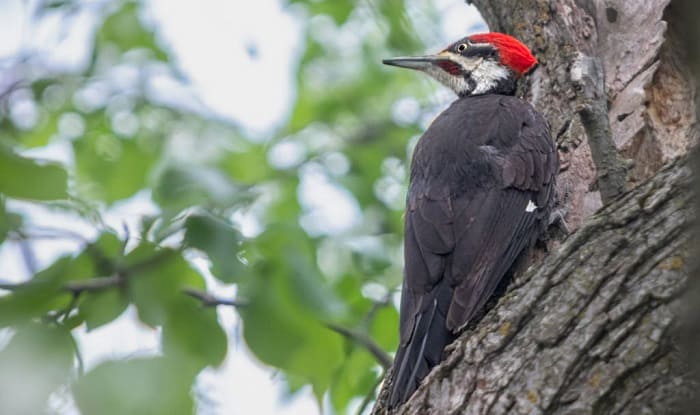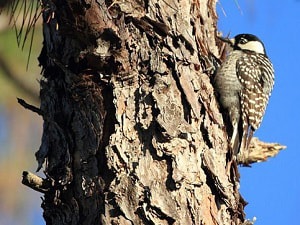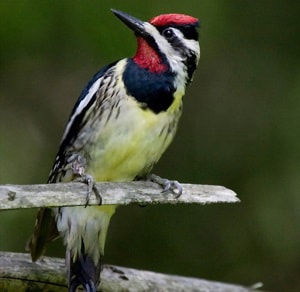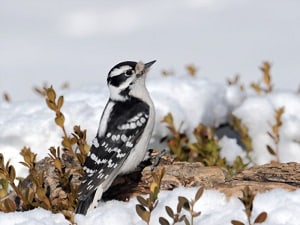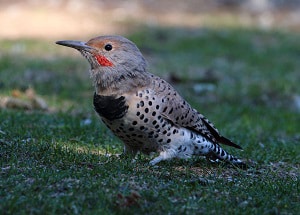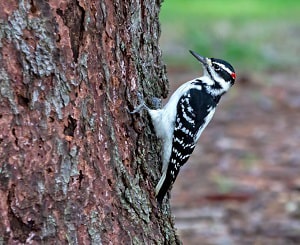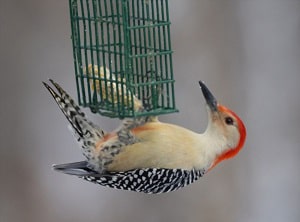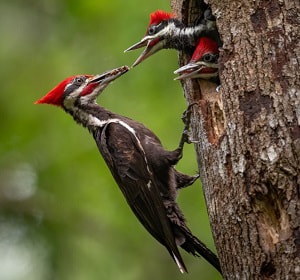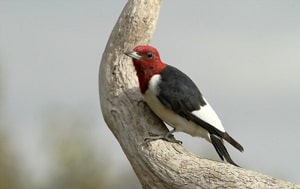The eight species of woodpeckers in Maryland are from one family of Picidae only. They all look the same in many ways, but they have differences too.
These woodpeckers are red-cockaded woodpeckers, pileated woodpeckers, downy woodpeckers, red-bellied woodpeckers, hairy woodpeckers, yellow-bellied sapsuckers, northern flickers, and red-headed woodpeckers.
The Old Line State is indeed lucky to have these woodpeckers in its various forests, agricultural lands, parks, and residential yards. Getting to know these hammering birds makes you a better birder.
Table of Contents
List of Woodpeckers Found in Maryland
A small woodpecker is super fun to watch, but so are the bigger ones. Maryland is the perfect home for eight woodpecker breeds, and they start a family in live and dead trees.
In this article, you’ll learn about their appearance, diet, and nesting information.
1. Red-cockaded Woodpecker
Scientific classification:
- Kingdom – Animalia
- Family – Picidae
- Species – L. borealis
- Genus – Leuconotopicus
- Class – Aves
- Phylum – Chordata
- Order – Piciformes
- Binomial name – Leuconotopicus borealis
There are eight types of Maryland woodpeckers, and one of the popular ones are the red-cockaded woodpeckers. These are small birds with a length of 7.1-9.1”, wingspan of 13-16”, and weight of 40-56g.
They can easily be identified thanks to their black cap and of course, the signature black and white pattern.
The red-cockaded woodpeckers survive by feeding on ants, spiders, caterpillars, beetles, wood-boring insects, and cockroaches. But they also munch on berries, fruits, and corn earworms.
Nesting Information
The red-cockaded woodpeckers opt to create holes for nesting in live trees with fungus. They choose to excavate their cavities 100’ from the earth, and the 2-3” entrances face the south or west direction. This bird breed uses wood fragments as a bed inside the hole and raises its baby birds there.
- Clutch size – 2-5 eggs
- Brood number – 1
- Incubation time – 10-11 days
- Egg length – 0.8-1.0”
- Egg width – 0.7-0.8”
- Egg description – glossy white
- Hatchling status – naked and defenseless
2. Yellow-bellied Sapsucker
Scientific classification:
- Kingdom – Animalia
- Family – Picidae
- Species – S. varius
- Genus – Sphyrapicus
- Class – Aves
- Phylum – Chordata
- Order – Piciformes
- Binomial name – Sphyrapicus varius
Woodpecker Maryland sounds are not really the same. For instance, the yellow-bellied sapsuckers have songs and calls of the following sounds:
- neaaah
- wee-wee-wee-wee
- qwee-owee
- kwee-urk
- wurp wurp
- week week
- quirk quirk
- quarr
Yellow-bellied sapsuckers are 19-21cm long, weigh 35-62g, and have a wingspan of 34-40cm. Males have a vivid scarlet temple, while females have a pale red hue. And their main food is insects.
Nesting Information
Yellow-bellied sapsuckers prefer to excavate their nest holes in live yet decaying trees due to fungus. The contamination paves the way for easier digging.
And in up to seven breeding seasons, the same holes are used for laying eggs. Males and females finish the nest construction in 2-3 weeks, and eggs are laid on top of wood chips.
- Clutch size – 4-6 eggs
- Brood number – 1
- Incubation time – 10-13 days
- Egg length – 0.8-1.0”
- Egg width – 0.6-0.7”
- Egg description – white
- Hatchling status – naked, cannot see, pink skin, gray beak
3. Downy Woodpecker
Scientific classification:
- Kingdom – Animalia
- Family – Picidae
- Species – D. pubescens
- Genus – Dryobates
- Class – Aves
- Phylum – Chordata
- Order – Piciformes
- Binomial name – Dryobates pubescens
The downy woodpecker is the smallest woodpecker in Northern America. They measure 14-18cm long, with a wingspan of 25-31cm, bills at 1-1.8cm, tails at 1.6-2.4”, and these birds weigh 20-33g.
The black hue covers the wings and upper of this woodpecker, while their stomach, throat, and back are white. They also have spotted wings and a black tail.
Downy woodpeckers feed primarily on insects, but they are also fond of berries and seeds. And in the cold months, they usually visit yard feeders, especially when they see peanuts and suet.
Nesting Information
Downy woodpeckers always build their nests in soft trees, particularly dead ones. They’re easier to excavate, plus they harbor plenty of insects.
Nest construction by mating pairs is completed after three weeks, with a measurement of 6-12” depth and 1-1.5” width. Downy woodpeckers don’t waste the wood fragments from excavating, since they utilize them as base for their nest.
- Clutch size – 3-8 eggs
- Brood number – 1
- Incubation time -12 days
- Egg length – 0.8”
- Egg width – 0.6”
- Egg description – white
- Hatchling stratus – naked, sharp bill tooth, shut eyes
4. Northern Flicker
Scientific classification:
- Kingdom – Animalia
- Family – Picidae
- Species – C. auratus
- Genus – Colaptes
- Class – Aves
- Phylum – Chordata
- Order – Piciformes
- Binomial name – Colaptes auratus
The northern flickers are also referred to as polka dot woodpecker, thanks to their unique plumage pattern. Their black and brown color combination is perfect for their breed.
This avian species has a length of 28-36cm, bill of 2.2-4.3cm, wingspan of 42-54cm, tail of 3-4.5”, and weight of 3-5.9 oz.
Northern flickers are notable for their ground-foraging habit. They simply love ants, and almost half of their diet consists of this insect.
Nesting Information
The East coast woodpeckers include the northern flickers. As woodpeckers, they do love to roost and nest in dead branches and soft trees.
Though they reuse the same trees for nesting every year, these birds make sure that their egg-laying spot is 6-15’ above the earth. The completed nests have an entry diameter of 3” and depth of 13-16”.
- Clutch size – 5-8 eggs
- Brood number – 1
- Incubation time – 11-13 days
- Egg length – 0.8-1.4”
- Egg width – 0.6-1.3”
- Egg description – white
- Hatchling stratus – naked, sharp egg tooth, pink skin, clumsy, shut eyes
5. Hairy Woodpecker
Scientific classification:
- Kingdom – Animalia
- Family – Picidae
- Species – L. villosus
- Genus – Leuconotopicus
- Class – Aves
- Phylum – Chordata
- Order – Piciformes
- Binomial name – Leuconotopicus villosus
A hairy woodpecker is a medium-sized bird at 7.1-10.2” long with a 13-17” wingspan and 1.4-3.4oz weight. Their black and white coloring is quite similar to other woodpeckers.
Males are recognizable with scarlet marks on their heads. Birders can identify this bird species through their short bills as well.
Hairy woodpeckers love insects, but they also munch on fruits, nuts, tree sap, and berries. And thanks to their preference for European corn borers, they help decrease the loss of crops.
Nesting Information
Hairy woodpeckers are smart creatures that build their nests in a way that predators cannot access their eggs or baby birds. They prefer dead trees and dig an entrance from underneath them. This woodpecker breed starts excavating their nests at least two weeks before mating.
- Clutch size – 3-6 eggs
- Brood number – 1
- Incubation time – 11-12 days
- Egg length – 0.8-1.0”
- Egg width – 0.7-0.8”
- Egg description – white
- Hatchling stratus – naked, sharp tooth, pink skin, shut eyes
6. Red-bellied Woodpecker
Scientific classification:
- Kingdom – Animalia
- Family – Picidae
- Species – M. carolinus
- Genus – Melanerpes
- Class – Aves
- Phylum – Chordata
- Order – Piciformes
- Binomial name – Melanerpes carolinus
Red-bellied woodpeckers are MD woodpeckers that, though named as such, the scarlet patch on their bellies are not entirely visible.
They have a black and white pattern on their wings and back and pale gray faces. Plus, they have a crimson head patch that makes them more attractive.
Red-bellied woodpeckers are loud birds with calls such as “thrraa-thrraa-thrraa”, “churr-churr-churr”, and “br-r-r-r-t”. They certainly love to tap anywhere. And they thrive on insects, fruits, seeds, and nuts.
Nesting Information
Red-bellied woodpeckers build their nests in dead trees, poles, dead branches of live trees, and fence posts.
In every breeding period, they may come back to the same tree, pole, or post to dig another hole for nesting. The base of their nest is made of wood chips, and the cavity itself has a circular design and a depth of 22-32cm.
- Clutch size – 2-6 eggs
- Brood number – 1-3
- Incubation time – 12 days
- Nestling period – 24-27 days
- Egg length – 0.9-1.1”
- Egg width – 0.7-0.9”
- Egg description – white
- Hatchling status – shut eyes, naked, defenseless
7. Pileated Woodpecker
Scientific classification:
- Kingdom – Animalia
- Family – Picidae
- Species – D. pileatus
- Genus – Dryocopus
- Class – Aves
- Phylum – Chordata
- Order – Piciformes
- Binomial name – Dryocopus pileatus
A pileated woodpecker is the biggest bird in the family of Picidae. This bird species has a length of 40-49cm, wingspan of 66-75cm, 14-17.4” long tail, and 7.9-14.1oz weight.
They are mostly black in color, with scarlet head “mohawks”, and a white bar running through the throat.
Pileated woodpeckers love carpenter ants and other insects, as well as berries, fruits, and nuts. They forage for meals in trees and on the ground. And the scarcity of natural food sources drives them to visit yard feeders.
Nesting Information
Like other woodpeckers, the pileated woodpeckers roost and nest in dead trees. The primary builders are the males, but the females help in the completion of their oblong nest.
They make use of the wood fragments from the excavation to create a wall in the cavity. The completed nest is usually a foot or so in measurement. And when mating, the pileated woodpeckers are known to have one partner for life.
- Clutch size – 3-5 eggs
- Brood number – 1
- Incubation time – 15-18 days
- Egg length – 1.2-1.4”
- Egg width – 0.9-1.0”
- Egg description – white
- Hatchling stratus – naked, defenseless
8. Red-headed Woodpecker
Scientific classification:
- Kingdom – Animalia
- Family – Picidae
- Species – M. erythrocephalus
- Genus – Melanerpes
- Class – Aves
- Phylum – Chordata
- Order – Piciformes
- Binomial name – Melanerpes erythrocephalus
Red-headed woodpeckers are some of the most beautiful Maryland woodpeckers with their tricolored design. Their back and tail are black. They have a scarlet neck and head, black wings, and white rump and stomach. Both sexes are similar in looks, and their vivid crimson heads are absolutely eye-catching.
These mid-sized woodpeckers can survive in the wild for 9.9 years. They mainly feed on insects, nuts, seeds, berries, and fruits, as well as tiny rodents and bird eggs. The red-headed woodpeckers always store food for future use.
Nesting Information
During the nesting season, the red-headed woodpeckers build their nests in dead trees, telephone poles, building crevices, and live tree branches.
And they’re known to reuse their holes again in the next breeding years. Nest building typically takes 12-17 days to finish, and their new home is 3-6” across with a depth of 8-16”.
- Clutch size – 3-10 eggs
- Brood number – 1-2
- Incubation time – 12-14 days
- Egg length – 1.0”
- Egg width – 0.8”
- Egg description – white
- Hatchling stratus – naked, eyes shut
Conclusion
Now that you know the eight species of woodpeckers in Maryland, your birding activities are much more fun. You now have the knowledge on how to differentiate each breed, and know what will attract the woodpeckers in terms of food and nesting.
Kindly take the time to share this article to your friends, family, and social media. And if you want to add suggestions or information, please feel free to let us know. We do welcome the thoughts of our avid readers.
Before you go, don’t forget to check out these related posts to other state birds:
- Some facts of the nene of Hawaii.
- What is the state bird of Pennsylvania?
- The represent bird of Kentucky.

George and I became friends after a birdwatching trip with our new group. And we have been enjoying every adventure together. When he told me the idea of establishing a site that shares our experiences and fun, I immediately agreed. After trials and errors, here we have Thayerbirding.


